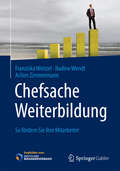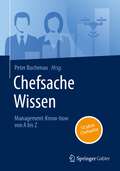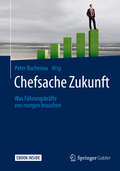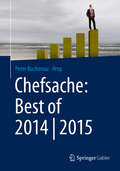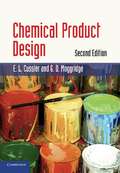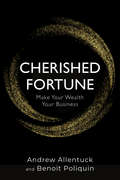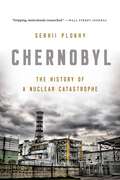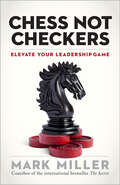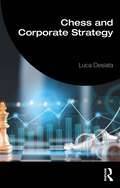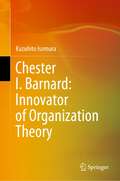- Table View
- List View
Chefsache Weiterbildung: So fördern Sie Ihre Mitarbeiter
by Franziska Weitzel Nadine Wendt Achim ZimmermannDas Fachbuch beleuchtet das Thema Weiterbildung von allen Seiten und geht dabei sowohl auf die strategische Weiterbildung mit Blick auf die Unternehmensentwicklung als auch die Weiterbildung als pers#65533;nliche Potenzialentfaltung ein. Welche Ver#65533;nderungen und neuen Blickwinkel sind n#65533;tig, um wettbewerbsf#65533;hig zu bleiben? Wo bestehen Gefahren und Chancen? Wie l#65533;sst sich der Bedarf an Weiterbildungsma#65533;nahmen ermitteln? Welche sind die Schl#65533;sselqualifikationen f#65533;r das 21. Jahrhundert? Die Autoren zeigen, wie Weiterbildungs- und Wissensmanagement gewinnbringend in das Unternehmen eingebracht werden k#65533;nnen. Au#65533;erdem wird erl#65533;utert, welche rechtlichen Grundlagen f#65533;r die Weiterbildung im Betrieb aus Arbeitsnehmer- und Arbeitgebersicht zu beachten sind.
Chefsache Wissen: Management-Know-how von A bis Z (Chefsache)
by Peter BuchenauVon der Arbeitswelt 5.0 über Digitalisierung, Motivation und Wertschätzung bis zur Zukunft des Handelns: In diesem Jubiläumsband erhalten Sie einen Überblick zu 26 Chefsache-Themen von A bis Z – wie immer lehrreich, praxisorientiert und umsetzbar. Neben den Softskills steht vor allem das Thema Veränderung im Fokus. Die Autoren sind gefragte Experten zum Thema Management und Führung, die internationale Konzerne, aber auch kleine und mittelständische Unternehmen beraten und genau wissen, worauf es wirklich ankommt. In ihren Beiträgen geben sie Unternehmern, Führungskräften und Chefs die Tools an die Hand, um Erfolge zu sichern und neue zu schaffen.
Chefsache Zukunft: Was Führungskräfte von morgen brauchen (Chefsache)
by Peter BuchenauDie Digitalisierung bedeutet mehr als nur Breitbandausbau. Die Digitalisierung wird in alle Lebensbereiche und Lebensformen einziehen. Das Zusammenleben zwischen Roboter und Mensch wird zum zentralen Mittelpunkt. Doch darf bei diesem digitalen Fortschritt der Mensch mit seinen Gefühlen, Ängsten und Emotionen nicht vergessen werden. 31 Unternehmer, Berater und Coaches wagen deshalb in diesem Buch einen Blick in die Zukunft und beschreiben wie sich das Leben und Arbeiten in den nächsten 10 Jahren in ihrem jeweiligen Fachgebiet, wie u.a. die Führung, der Vertrieb, die Umsetzung, die Gesundheit und die Sicherheit von Menschen im Unternehmen und somit auch in der Gesellschaft von Morgen, verändern werden. Die Autorinnen und Autoren geben Zuversicht und machen Mut, sich auf die Anforderungen der Zukunft vorbereiten zu können.
Chefsache: Best Of 2014-2015
by Peter BuchenauDie Chefsache-Reihe von Peter Buchenau führt innovative Autoren verschiedenster Branchen und Denkansätze zusammen und beschäftigt sich mit Themen rund um Gesundheit, Prävention, Betriebskita, Kopf, Social Media Marketing, Leisure Sickness, Männer oder Frauen. Die 34 erfolgreichsten Beiträge aus 2014/2015 werden hier in Kurzform noch einmal dargestellt. Alle Autoren sind in ihrem jeweiligen Fachgebiet anerkannte Experten. Mit ihren Texten tragen sie dazu bei, Ihren unternehmerischen und auch persönlichen Erfolg nachhaltig zu sichern. Durch die komprimierte Form der dargestellten Expertentipps eignet sich dieser Chefsache-Band besonders für den schnellen Leser, der wenig Zeit hat.
Chegue à primeira página do Google: Dicas de SEO para marketing online
by Jason Matthews Antonio Jorge SantosEste livro é dedicado aos donos de sites e blogs que fazem o que podem para melhorar a performance dos seus sites. Eu sei como é. Desejo que você possa alcançar as pessoas de todo o mundo. Chegue à primeira página do Google com dicas fáceis de SEO. Um pouco de SEO (Search engine optimization), pode colocar qualquer site no topo sem gastar dinheiro. Descubra maneiras de usar as palavras-chave, meta descrições, tags, categorias, títulos, link-building e muito mais. Instruções passo a passo para colocar o seu site na primeira página do Google. Qualquer um pode fazer isso. Não vai custar nada mais que um pouco de tempo. Você vai descobrir: As melhores palavras-chave, tanto de cauda curta quanto de cauda longa; Meta tags com meta descrições para o código fonte da página; Maneiras para otimizar textos e imagens; Back-links para outros sites; Como monitorar as tendências dos visitantes; Plataformas online e acréscimo de visibilidade; Ferramentas de mídias sociais (Google Plus, Facebook, Twitter, etc.); Como fazer network com pessoas de todo o mundo; E muito mais... Dentro de algumas semanas ou meses, você vai ver resultados reais e vai chegar à primeira página.
ChemBright, Inc.
by Janice H. HammondChemBright is a small start-up company that manufactures private-label household chemicals. The company sells its products to grocery chains in the New England area. Its strategy is based on a significant logistics-based cost advantage. The primary case decisions are 1) how the company should respond to a price war initiated by a strong competitor, and 2) how the company can continue to exploit its logistics advantages as it pursues different growth alternatives. Acts as an effective introduction to logistics, and, in particular, to the fact that logistics is not a purely tactical function, but can be used as a powerful competitive weapon.
Chemalite, Inc.
by David A. WilsonA chemical engineer who has set up a company to manufacture and market one of his inventions is trying to prepare his state of the corporation report. This case is designed to serve as a vehicle to introduce students to basic bookkeeping and accounting functions.
Chemalite, Inc. (B): Cash Flow Analysis
by Robert L. Simons Antonio DavilaStudents are asked to use actual and pro forma financial statements to prepare a statement of cash flows under both the direct and indirect method.
Chemdex.com
by William A. Sahlman Michael J. Roberts Laurence E. KatzAn Internet start-up company is developing an online marketplace for specialty chemicals and reagents. David Perry has been named a runner-up in the 1st annual HBS Business Plan contest and now faces seed-stage financing questions--how much money to raise, at what valuation, in how many stages, and from whom.
Chemdex.com Business Plan
by Lynda M. ApplegateTakes readers back to the original business plan developed by Chemdex founder, Dave Perry, in May 1997. Teaching Purpose: Accompanied by a tool that enables analysis of the business model.
Chemical Bank: Allocation of Profits
by Kenneth A. Merchant Carolyn M. BitettiDescribes a conflict between the metropolitan (branch banking) and treasury groups at the bank. The issue is which group should receive the profits generated by a product involving both: Due bills. It is a form of transfer pricing problem, but in a unique (i.e., service) setting.
Chemical Bank: Implementing the Balanced Scorecard
by Robert S. Kaplan Norman KleinThe retail bank division of Chemical Bank faces declining margins and increased competition in its credit and deposit gathering and processing business. It wishes to implement a new strategy to become a preferred financial service provider to target customer groups. The division adapts the balanced scorecard to clarify and communicate the new strategy and to identify the key drivers for strategic success. The case describes the development of strategic objectives and measures for four perspectives: financial, customer, internal, and learning growth, and the process for implementing the new measurement and management system.
Chemical Product Design
by E. L. Cussler G. D. MoggridgeThe chemical industry is changing, going beyond commodity chemicals to a palette of higher value added products. This groundbreaking book, now revised and expanded, documents this change and shows how to meet the challenges implied. Presenting a four-step design process – needs, ideas, selection, manufacture – the authors supply readers with a simple design template that can be applied to a wide variety of products. Four new chapters on commodities, devices, molecules/drugs and microstructures show how this template can be applied to products including oxygen for emphysema patients, pharmaceuticals like taxol, dietary supplements like lutein, and beverages which are more satisfying. For different groups of products the authors supply both strategies for design and summaries of relevant science. Economic analysis is expanded, emphasizing the importance of speed-to-market, selling ideas to investors and an expectation of limited time in the market. Extra examples, homework problems and a solutions manual are available.
Chemie für Einsteiger
by Josef K. FelixbergerDas Buch ist eine leicht verständliche Einführung in die Welt der Chemie mit hohem praktischem Nutzen, angereichert mit zahlreichen anschaulichen Beispielen aus Alltag, Industrie, Wirtschaft, Politik und Geschichte. Eine reich bebilderte Darstellung der Allgemeinen und Anorganischen Chemie, der Organischen Chemie und Biochemie und last, but not least der Polymerchemie und Kunststoffverarbeitung. Gleichermaßen empfehlenswert für Studienanfänger mit Nebenfach Chemie, für Kaufleute und Techniker, Schüler und Lehrer sowie für interessierte Laien.
Chemistry: The Key To Our Sustainable Future
by Henri Li Kam Wah Ponnadurai Ramasami Minu Gupta Bhowon Sabina Jhaumeer-LaullooChemistry: The Key to our Sustainable Future is a collection of selected contributed papers by participants of the International Conference on Pure and Applied Chemistry (ICPAC 2012) on the theme of "Chemistry: The Key for our Future" held in Mauritius in July 2012. In light of the significant contribution of chemistry to benefit of mankind, this book is a collection of recent results generated from research in chemistry and interdisciplinary areas. It covers topics ranging from nanotechnology, natural product chemistry to analytical and environmental chemistry. Chemistry: The Key to our Sustainable Future is written for graduates, postgraduates, researchers in industry and academia who have an interest in the fields ranging from fundamental to applied chemistry.
Chemours (A)
by David Lane David G. FubiniThe July 2015 spin-off of DuPont's performance chemicals division as the independent company Chemours burdened new CEO Mark Vergnano and his team with perilous challenges. Despite market-leading offerings in several areas, the company faced a glutted market for its primary product, even after its prices had fallen 40% since 2012. The company also owed $4 billion in long-term debt, equivalent to 10 times 2014 earnings. Not least, DuPont had made Chemours financially responsible for chemical contamination at 171 U.S. sites, representing 62% of DuPont's environmental liabilities and 90% of its litigation by number of pending cases. Within six months, Chemours shares had lost 80% of their value.
Chemours (B)
by David Lane David G. FubiniSupplement to (A) describing actions taken by Chemours CEO Mark Vergnano and members of his executive team to execute a successful turnaround of the company.
Cherished Fortune: Make Your Wealth Your Business
by Andrew Allentuck Benoit PoliquinHow new investors can start using a small-business mindset to maximize their wealth. An early start in investing can be a huge advantage, but investors must quickly learn to make the most of opportunities. Thinking like a small-business owner can yield great benefits to investors’ portfolios. Running a small business means selling goods you know inside and out to customers you know equally well: what they like, what they buy, what they reject. Using a similar mindset, novice investors can manage their portfolios by understanding what works, controlling risk, and building knowledge. It’s about knowing the details of what is in their portfolio and how each stock, and the company behind it, operates. Columnist Andrew Allentuck and financial planner Benoit Poliquin give new investors a much-needed introduction to the critical skills that will maximize their investments’ values over their lifetimes.
Chernobyl: The History of a Nuclear Catastrophe
by Serhii PlokhyFrom a preeminent historian of Eastern Europe, the definitive history of the Chernobyl nuclear disaster On the morning of April 26, 1986, Europe witnessed the worst nuclear disaster in history: the explosion of a reactor at the Chernobyl Nuclear Power Plant in Soviet Ukraine. Dozens died of radiation poisoning, fallout contaminated half the continent, and thousands fell ill. In Chernobyl, Serhii Plokhy draws on new sources to tell the dramatic stories of the firefighters, scientists, and soldiers who heroically extinguished the nuclear inferno. He lays bare the flaws of the Soviet nuclear industry, tracing the disaster to the authoritarian character of Communist party rule, the regime's control of scientific information, and its emphasis on economic development over all else. Today, the risk of another Chernobyl looms in the mismanagement of nuclear power in the developing world. A moving and definitive account, Chernobyl is also an urgent call to action.
Cherrypicks
by William R. KerrCherrypicks is a Hong Kong communications start-up approaching a large Korean mobile operator for a partnership to take the operator's products to markets outside of Korea. SK Telecom's (SKT) Ring Back Tones (RBT) product is a spectacular success in South Korea, but the partnership will require major changes in Cherrypicks' business model. Further complicating matters, SKT is also a strategic investor in Cherrypicks, a very large service provider focused on South Korea and China, and typically partners with Korean entrepreneurial firms. The Cherrypicks management team must decide how they should pitch the partnership opportunity to SKT and what their preferred deal structure would be.
Chesapeake Conservancy: Democratizing Data to Protect 30% of the Planet by 2030
by Lynda M. Applegate Ankita PandaCase
Chess Not Checkers: Elevate Your Leadership Game (The High Performance Series #1)
by Mark MillerAs organizations grow in volume and complexity, the demands on leadership change. The same old moves won't cut it any more. In Chess Not Checkers, Mark Miller tells the story of Blake Brown, newly appointed CEO of a company troubled by poor performance and low morale. Nothing Blake learned from his previous roles seems to help him deal with the issues he now faces. The problem, his new mentor points out, is Blake is playing the wrong game.The early days of an organization are like checkers: a quickly played game with mostly interchangeable pieces. Everybody, the leader included, does a little bit of everything; the pace is frenetic. But as the organization expands, you can't just keep jumping from activity to activity. You have to think strategically, plan ahead, and leverage every employee's specific talents—that's chess. Leaders who continue to play checkers when the name of the game is chess lose. On his journey, Blake learns four essential strategies from the game of chess that transform his leadership and his organization. The result: unprecedented performance!
Chess and Corporate Strategy
by Luca DesiataChess and Corporate Strategy is an intriguing journey through cognitive psychology, artificial intelligence, and game theory. The innovative methodology employed by the author leverages the metaphor of chess to furnish a compendium of corporate strategy, including strategic thinking, decision-making, negotiations, and leadership.This book provides the reader with the insights and strategies of chess champions, without the need for years of study and practice. Throughout this book, captivating episodes from the rich history of the game of chess weave seamlessly, elevating the reading experience beyond that of a conventional management publication. Every chapter is enriched by insightful interviews featuring Anatoly Karpov, the 12th chess world champion. Karpov adeptly illustrates the practical application of theoretical concepts in the professional realm through real-life examples.This book will be a valuable resource to leaders and executives interested in innovative ways of thinking about corporate strategy and the running of a business.
Chester I. Barnard: Innovator of Organization Theory
by Kazuhito IsomuraThis book looks at Chester I. Barnard’s theoretical and practical contributions to organization theory by examining his life, career, experience, intellectual relationships, philosophy, method, and theory.Barnard (1886–1961) is considered an innovator in the field with the publication of his seminal work, The Functions of the Executive, in 1938. But why was Barnard able to publish such a groundbreaking book despite the fact that he was a practitioner, not an academic researcher? In pursuit of that question, this book carefully investigates the background of his ideas about management, such as his experience, philosophy, and method. It then traces the process of how Barnard built his concepts of organization as it examines his books, published papers, unpublished manuscripts, and correspondence and systematically summarizes how he built his theory of organization and management. Finally, the author explores how Barnard’s theory has the potential to be developed and put into practice by examining his important works after his publication of The Functions of the Executive, which is well known as abstract and difficult. Readers of this present book will come away with a clearer and more systematic understanding of Barnard’s theoretical and practical contributions to the field.
